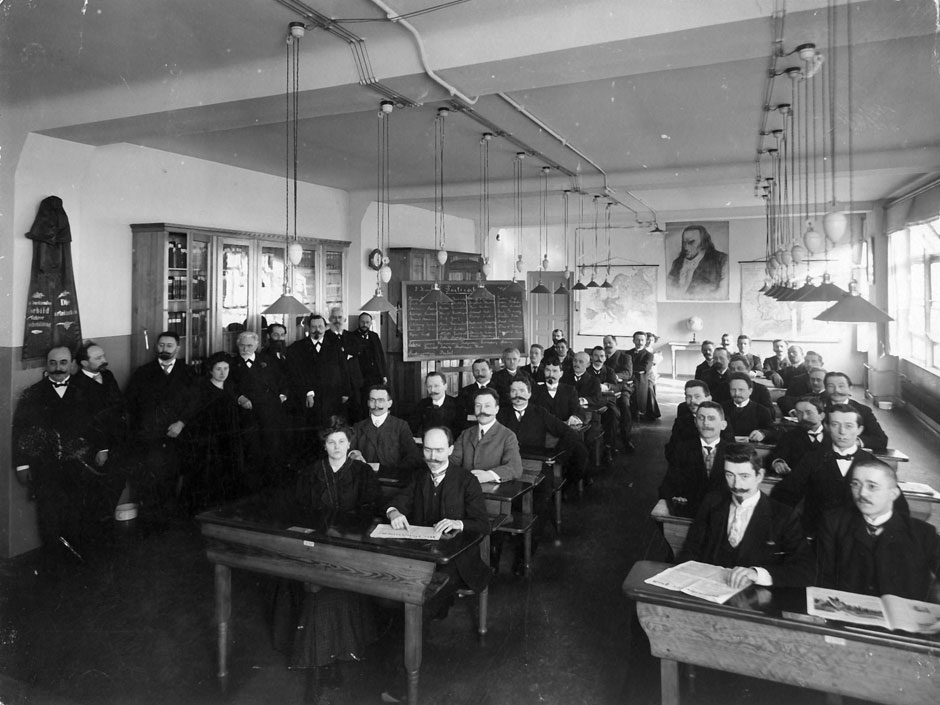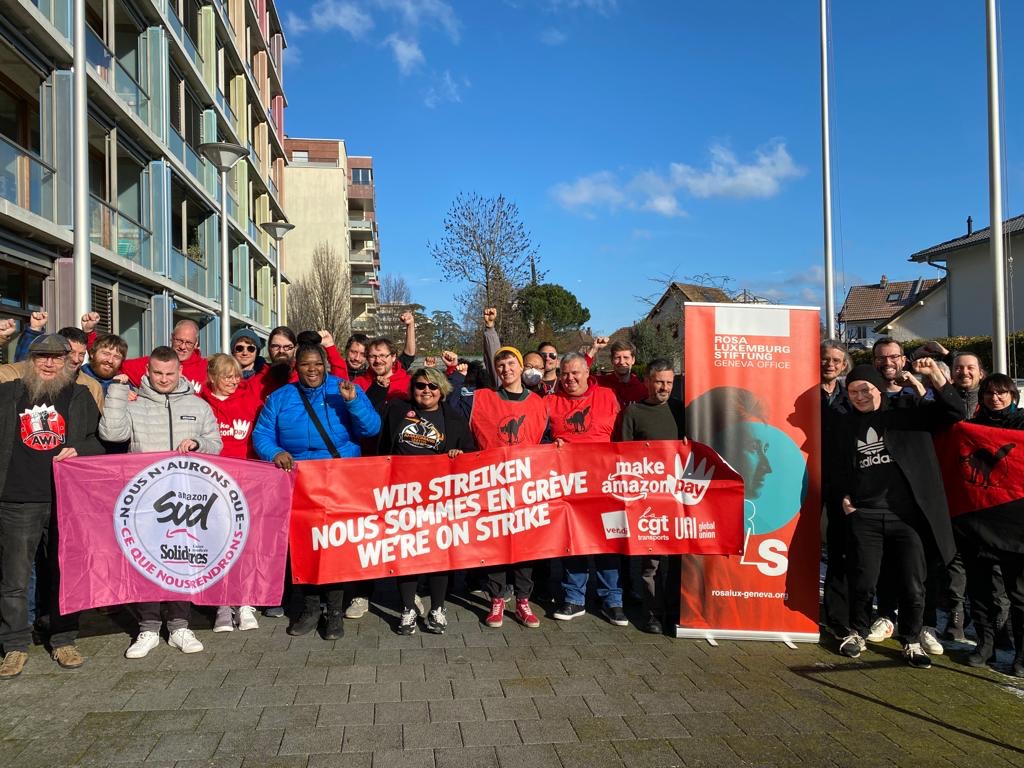Aktie Twitter Facebook Email Copy URL
As a teacher at the SPD party school, Rosa Luxemburg taught worker-militants to see the world like a Marxist – in englischer Sprache!

For Rosa Luxemburg, political education was hardly just a matter of sitting down in the classroom. In her work The Mass Strike, responding to the 1905 revolution in the Russian empire, she emphasized how the masses learned through experience. As she wrote, “to be able to overthrow [Russian absolutism], the proletariat requires a high degree of political education, of class-consciousness and organization. All these conditions cannot be fulfilled by pamphlets and leaflets, but only by the living political school, by the fight and in the fight, in the continuous course of the revolution.”
Yet if here Luxemburg wrote that “revolutions do not allow anyone to play the schoolmaster,” the following year she became a teacher at the German Social Democrats’ (SPD) national party school in Berlin. There, she taught several cohorts of students, an experience which also informed works like her Introduction to Political Economy, seeking to popularize Marxist economics among militants. The classroom couldn’t make the revolution happen. What it could do was empower militants to think differently, while also enriching party theory with its worker-students’ experiences.
Origins of the Party School
The party school at which Luxemburg taught was founded in 1906, but was far from the first time that the SPD engaged in active political education. In fact, the party’s history can be traced back to workers’ education clubs founded after the 1848 revolution. Most of these clubs were founded by radical liberal intellectuals guided by the idea that educational clubs and institutes for workers could improve their lives through individual cultural and spiritual enrichment. Some of the first workers’ organizations in Germany were the result of workers splitting from clubs founded under bourgeois patronage in favour of running their own independent political and educational organizations.
Prominent early SPD leaders like Wilhelm Liebknecht often referred to the socialist party as a party of education, where “education” stood for all party activity that helped foster the development of working-class consciousness and a socialist worldview. Yet the late nineteenth century also saw major changes in the conditions in which such activity took place. From 1878 to 1890 the SPD had been a clandestine organization, banned under the anti-socialist laws. Yet it soon became a genuine mass party, winning one-third of the popular vote by 1903; and boasting six hundred thousand members by 1906.
As these shifts took place, calls for the SPD to play a more active role in worker education became more pressing. The party’s expansion brought a massive growth in the middle ranks of the party, with an increase in national-level coordination, the institution of regional instead of just local organizational bodies, and the employment of more full-timers. A series of debates on workers’ education in the pages of the party’s theoretical journal, Die Neue Zeit, in 1904 and 1905, and further discussions at the 1906 party congress, led to the formation of a national party school.
The school immediately encountered scepticism. Firstly, because it was seen as a hotbed of radicalism, with several prominent intellectuals from the party’s left wing on staff—Luxemburg chief among them. After the school’s inaugural year, state authorities forced the resignation of two teachers—Anton Pannekoek and Rudolf Hilferding, both non-German nationals—by threatening their deportation. Luxemburg was invited to take over Hilferding’s section on political economy and economic history. She taught this course each winter from 1907 until 1914 when the school was closed down upon the outbreak of World War I.
Teaching the Class
This period in SPD history was contradictory. Its bureaucratic growth played a significant role in feeding the party’s conservatism during the decade before the war, yet it also brought with it the creation of institutions like the school that provided platforms for cadres to spread revolutionary thought and propaganda. In 1906 it established both the party school in Berlin, and a new set of touring lecturers. Unlike the mass-oriented and accessible touring lecture circuit, local reading and discussion clubs, and readily available pamphlet literature, the party school was a self-consciously elite institution.
Analogous to a socialist university, it monopolized the time of several top party intellectuals for six months at a time, in service of the education of only around thirty students per year. The course list for the first year included seven subjects in total, broadly covering economics, political history, historical materialism, oral and written communication skills, and several aspects of law relevant to trade union and party organizing.
But if the school is sometimes likened to a university, it should also be remembered that its students were a much more motley crew than the average undergraduate seminar today—and a world apart from the students likely to attend a German university in this era. One difference was that at the party school you would see a woman or two in attendance; it had one woman student in 1906–7 and two the following year, whereas the first woman was officially enrolled at Berlin’s state university only in 1908.
Students were nominated at the discretion of local party committees, with attention paid to regional diversity; they also varied in age. Some committees sent young workers who showed promise, while others sent stalwart cadres who had been loyal party members for decades. While around one-third of the students each year were employed directly by the party before attending the school—whether as party newspaper editors or typesetters, or in administrative or agitational roles—many also came directly from manual jobs. The single most common job for a student was carpenter, followed by typesetter, tailor, and bricklayer; after leaving the school, around a quarter went back to their original jobs, while most began working directly for the party. Despite the diversity of students, their praise for the school was overwhelming—especially for Luxemburg’s teaching.
During the teaching term, which ran from October through March, she held lessons for two hours each day. Students were instructed from 8:00 until 13:00 and Luxemburg often made herself available to her students in the afternoons. Not content to simply lecture in the manner traditional to the university, she set out to help party school students become fully fledged Marxists in their own right.
This meant making them capable not only of learning simplified or summarized economic facts and lessons but of gaining the capacity to analyze and interpret new information and solve problems they were sure to face in their roles as party or trade union officials, journalists, and agitators. She was by all accounts highly successful, proving to be a natural teacher, able to engage and challenge her students without intimidating or patronizing them. Reflecting on her skill, one student from the 1912 cohort, Rosi Wolfstein, recounted her method:
How did she bring us to critically reflect and independently interrogate issues of political economy? By means of questions! By means of questions and more questions, she managed to extract from the class whatever knowledge there may have existed on a given issue. By means of questions, she tapped along the walls of our knowledge and thus enabled us to hear for ourselves where and how it sounded hollow. She explored the arguments and made us see for ourselves if they were sound, and by encouraging us to acknowledge our own errors, she led us to develop an airtight solution.
The core of Luxemburg’s commitment as a teacher was to instil a fluency in the historical materialist method. It was not enough to simply hold lectures on the basis of economic history, or to simplify the conclusions of Marx’s Capital into easily digestible summaries, but to provide the students with the skills necessary to continually develop their own analytical capacities.
First-hand accounts such as Wolfstein’s are not the only available source of insight into Luxemburg’s method of teaching; indeed, several surviving written notes and manuscripts of her lessons have recently come to light and are now published in English. The first volume of The Complete Works of Rosa Luxemburg includes manuscripts corresponding to her lectures on the second and third volumes of Marx’s Capital, as well as economic history topics, slavery in the ancient world, and feudalism. Teaching and discussing with students at the school itself led to her main economic writings, The Accumulation of Capital and Introduction to Political Economy.
Learning from Teaching
Introduction to Political Economy was intended to be a popular work of economic theory and history, and an introduction to the Marxist method, offering a wider audience the opportunity to engage with the material she covered in the party school. She intended it to be published first as a set of pamphlets and later collected into a book. She began work on the introduction in 1907 but—stretched thin between teaching, campaigning, and agitational work as well as her journalistic interventions in both Germany and Poland—she had little time to work on this longer methodical project.
Beyond lack of time, Luxemburg found that writing “introductory” material in fact raised questions that demanded deeper consideration. One such area was a problem she identified as Marx’s failure to identify the specific tendencies of capitalist development that would lead to greater and greater crises. She wrote The Accumulation of Capital to address this issue. Here, she proposed a theory that placed the expansion of capitalism into new territories (new markets) through imperialism as the key explanation of how the process of capital accumulation would develop. She further postulated that the inability of this expansion process to continue at the same rate indefinitely would lead to increasingly catastrophic economic and political crises.
Published in 1913, The Accumulation of Capital was a work of detailed economic analysis intended for an audience with an advanced knowledge of contemporary debates in political economy. Such debates were beyond the understanding of almost all party members—including most party-school students. But she also elaborated its arguments in party-school teaching material regarding the second volume of Marx’s Capital. So, while ordinary militants may not have been the intended audience for this text, Luxemburg’s work as a teacher, and her belief in the capacity of party members to learn and engage in complex theoretical matters, benefited their development as socialists and Marxists as well as her own.
Learning to Think
While the school was praised by its students, it faced criticism from figures on the party’s more reformist wing, like Eduard Bernstein, who accused the left of using party education to advance their factional agenda—fretting that a teaching cohort of Marxist intellectuals would be overly dogmatic in their methods. Debate over the party school came to a head at the SPD congress in 1908 following a newspaper article critical of the party school, and what began as debate over education quickly gave way to a thinly veiled debate over the value of teaching and learning theory in general.
Rosa Luxemburg took the stage in defence of the school and of the importance of theoretical education. She defended their seemingly impractical theoretical instruction on the grounds that the party’s role should be to provide workers the means to systematize information about the world, and to channel it into useful knowledge that guides radical action. She concluded her speech by insisting that workers have a wealth of understanding from their experience living under capitalism, but that “what the masses lack is general enlightenment, the theory which gives us the possibility of systematizing the hard facts and forging them into a deadly weapon to use against our opponents.”
Sceptics favoured a “less ambitious programme” for the school. They considered “facts” that could help workers make practical decisions more important than trying to teach them theory. In this view, even if the party only helped workers achieve the basic “bourgeois” education that state institutions failed to provide, it would be helping them greatly. To the school’s defenders, this argument was an attack on the value of Marxist theory—the core of the party’s guiding ideology established in the Erfurt Programme in 1891.
Worse, it harkened back to an earlier era when workers’ organizations were nothing more than educational clubs lead by liberal reformists who promised that individual cultural betterment would lead to personal improvement. This implied a paternalistic understanding of the relationship between the masses and intellectuals, with the latter in the guise of enlightened social reformers.
To defenders of the school like Luxemburg, the suggestion that the party should concern itself with basic education (something which should be the role of the state) or limit itself to spreading only the most basic propagandistic formulations of Marxism, was in contradiction with the most fundamental principle of revolutionary socialism: worker self-emancipation.
The General Rules of the First International had opened with the statement “the emancipation of the working classes must be conquered by the working classes themselves.” For Luxemburg this meant building the capacity of workers at every level of the party capacity, so they could mount independent analysis and action without constantly relying on interpretations and guidance from party intellectuals.
Unsurprisingly, her students were often the school’s strongest defenders. Responding to the suggestion that students were simply being indoctrinated by party radicals, one protested that the teachers were committed to development of free thinking, and that Luxemburg particularly stood out as she “not only tolerated dissenting opinions, but also knew how to provoke critical thought with astonishing skill.”
It might be difficult to imagine how something as specific and distant from practical life as a lecture on slavery in the ancient world was supposed to help future trade union functionaries do their job better. But looking at her writings in combination with first-hand accounts of her role in the party school, we appreciate how Luxemburg mastered the skill of teaching not what to think but how.
As Peter Hudis puts it in the introduction to her party school texts, published in the first volume of her economic writings, “Luxemburg does not bring in history as a way of providing examples of theoretical concepts; instead, the complexity and importance of the concepts are elucidated by analyzing history in their light.” Luxemburg sought to teach workers not just what Marxism is, but how to be Marxists in their own right.
Julia Damphouse is the Reading Groups Coordinator for Jacobin, where this article first appeared. She is currently a History MA student at Humboldt University Berlin and holds a scholarship from the Rosa-Luxemburg-Stiftung.



